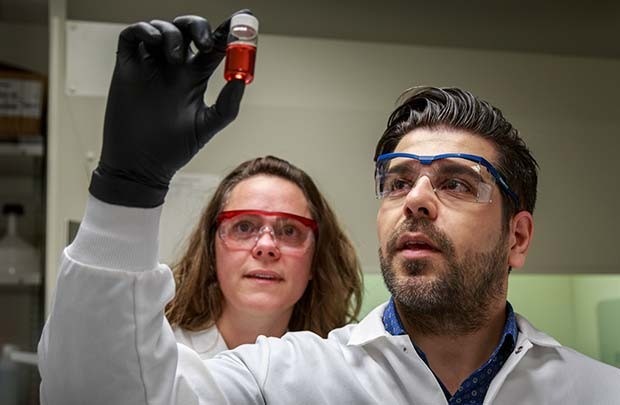
By using gold nanoparticles to deliver gene therapy agents to stem cells, researchers from the Fred Hutchinson Cancer Research Center have made a breakthrough in gene-editing capabilities and potential disease treatment. Typical gene therapies via CRISPR systems use electric shock or viral vectors to deliver the editing tools to targeted DNA, but this work published in Nature Materials suggests that gold nanoparticles may serve as a more scalable delivery vehicle.
A Novel Use of Gold Nanoparticals in CRISPR
Use of a gold nanoparticle equipped with CRISPR molecules to manipulate haematopoietic stem cells has not been documented prior to this work. These stem cells give rise to all blood cells and targeting them with gene therapy could potentially treat a myriad of diseases, such as sickle cell anemia and HIV. The CRISPR-gold complex was tested in human haematopoietic stem cells in this study and was found to yield no unwarranted side effects.
How Is CRISPR Delivered?
One way to deliver CRISPR therapies to alter disease-causing genes involves the use of viruses. These viruses are modified to carry the CRISPR complex and use their natural invasive techniques to enter targeted cells and deliver the gene therapy. This approach is effective; however, it comes at a great cost. To make enough viral vectors to treat 12 patients costs roughly $500,000 and takes one year of work. Additionally, the engineering of these viruses requires extremely advanced facilities that are often not available in regions with high rates of infection. Researchers also have little control over where these viral carriers deliver CRISPR compounds, and in some cases, they have been found to make genetic changes that trigger cancer formation.
READ MORE: Scientists Transform Skin Cells into Embryo Stem Cells
Another approach to delivering CRISPR is electroporation, a technique in which a cell is induced to form temporary openings in its membrane via electric shock. This allows the genetic-editing tools to enter, but can damage or kill the cells in the process.
Use of gold as a delivery vehicle presents several improvements in comparison to these traditional approaches. Lead researcher Dr. Reza Shahbazi of the Fred Hutchinson Cancer Research Center notes that one added benefit is that the size of the nanoparticles can be manipulated.
“Gold has lots of special characteristics that we can take advantage of,” he said. “Scientists can easily play around with the size of the particles, for example. That’s important because different sizes are used to target different parts of the body.”
Another benefit that gold presents is the particles can be coated with polyethylenimine. Doing so gives the particles a greater positive charge, allowing them to be absorbed more efficiently by the cells. Though this uptake mechanism may not be as efficient as electroporation, all cells that received CRISPR-gold therapy survived and fared better than untreated stem cells.
Once a particle is engulfed by a cell, it is typically bombarded with degradative acid to break it down. The gold nanoparticle’s charge; however, allows it to interact with the acid in a manner that frees it from the ingested vesicle and allows it to enter the nucleus to interact with genes.
Background of the Fred Hutchinson Study
The Fred Hutch team conducted two separate experiments to test their CRISPR-gold technique, the first of which targeting the CCR5 gene. The manipulation of this gene has been identified as a possible means of inducing HIV resistance. The second experiment was conducted to mutate the gamma hemoglobin gene to be better controlled. This gene is normally inactivated, but its activation can combat disorders such as sickle cell.
“We believe we have a good candidate for two diseases — HIV and hemoglobinopathies — though we are also evaluating other disease targets where small genetic changes can have a big impact, as well as ways to make bigger genetic changes,” said Dr. Jennifer Adair, an assistant member of the Clinical Research Division at Fred Hutch. “The next step is to increase how much gene editing happens in each cell, which is definitely doable. That will make it closer to being an effective therapy.”
These edited human stem cells were implanted into murine models and remained present in the mice 22 weeks later. Gene-editing peaked at eight weeks after the injection, and the team noted the presence of edited cells in the bone marrow, thymus, and spleen, indicating that the treatment would not need to be readministered for the effect to remain.
These treated cells were in better health than the untreated controls, indicating that the CRISPR-gold technique worked effectively. This approach was successful in making genetic edits in 10 to 20 percent of the targeted cells, which may not be comparable to electroporation, but offers a much safer means of doing so. The team hopes to bolster this number to 50 percent of the cells edited and intends on forming commercial partnerships to develop human therapies and conduct clinical trials.
Though this was the first-time researchers have used gold nanoparticles to deliver CRISPR therapies to haematopoietic stem cells, previous work has used CRISPR-gold compounds with other targets. A Nature Biomedical Engineering article published last June details a study in which UC Berkeley researchers used gold nanoparticles to administer CRISPR-Cas9 to the brain in mouse models of autism. This technique was successful in eliminating genes and behaviors associated with the disease.
So you thought $2.1 M was expensive for gene therapy?
Well, that was before the gold nanoparticles were added 😉
JK. Nice paper @NatureMaterials https://t.co/laLozIwcXB from @fredhutch for enhancing #CRISPR genome editing cell/nucleus delivery pic.twitter.com/iPMMEq984A— Eric Topol (@EricTopol) May 27, 2019







 © 2025 Mashup Media, LLC, a Formedics Property. All Rights Reserved.
© 2025 Mashup Media, LLC, a Formedics Property. All Rights Reserved.